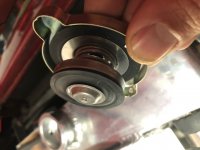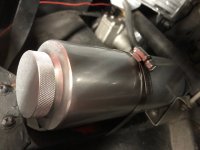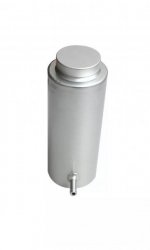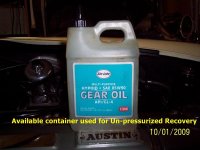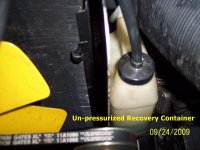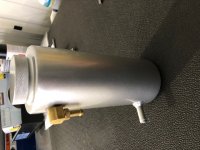...How would a non vented tank even work?
As (un)luck would have it, I just replaced such a tank on my mom's 2000 Lincoln LS with a 3.9L V8. I believe this is a British-designed and manufactured engine as, supposedly, it is the same as used in the S-Type Jags of the era. As this engine is British-designed, what should have been a simple 20-minute R&R turned into a multi-hour torture test.
I haven't had the plastic cover off in a while, but IIRC the radiator has no top tank. Presumably, this is to allow for the low front profile of these cars--they do have excellent visibility over the bonnet--so this plastic bottle serves as the top tank/reservoir/pressure bottle of the radiator. The cap notes it is '16PSIG,' and it does retain a lot of pressure when hot. It is also called a 'degas bottle' in the shop manual, but all the parts houses call it an 'overflow tank' (or bottle). The Lincoln sprang a coolant leak, and as an uncle of mine's wife had a similar car he told me the bottle was likely the problem, so I set about what should have been a simple fix (removing the coolant in the tank was going to be messy, no matter what). The tank is bolted-in near the scuttle, but getting to it was not an issue; the problem is that the half-inch return hose was at the bottom of the tank, was cut to the shortest length possible, affixed with one of those PITA spring clamps and routed under the brake reservoir and booster (I suppose this would not be an issue with a R/H drive car). After finally wrangling the tank out the problem was obvious: it was a plastic tank made from two parts with a seam about the middle, but had developed a 6-inch crack height-wise (not too surprising at 85K miles and 18 years). As bad as getting the tank out was, getting a replacement back in was thrice as bad; I finally gave up on the spring clamp and used a good ol' worm drive hose clamp (note even this would not have been possible had I not borrowed a set of those extra long needle nose pliers from a friend). As the highest point on the engine cooling system sits higher than the radiator, there is a cap on the top of the engine in which coolant must be added after losing some, and after a heating/cooling cycle (I call this 'burping' the engine). The car does have one nice feature: there is a hose to, presumably, the highest point in the heater core, through which you can bleed air from the core (you open a valve until hot coolant sprays in your face and and all over the engine then scramble to close it).
So, to answer the question, a non-vented tank would probably be used in lieu of a top radiator tank. As the manual called it a degas bottle coolant from the radiator comes in in a smaller hose at the top of the tank, and the larger hose returns it to the radiator (gas would percolate to the top of the bottle). There was a third hose fitting, but it was not connected to anything; I presume this is to allow coolant to spray all over the engine should the pressure exceed 16PSI and the cap relieves it. This issue is related to a problem a lot of newer cars have: the radiators may have a metal--usually aluminum--core, many have plastic tanks on either or both sides or the top. Given the expansion/contraction cycles, and the fact most are manufactured in two parts and somehow bonded together almost all of them will crack and leak eventually. I've replaced a couple before. I don't think you'd want a conventional overflow tank without a vent, when the engine cools the coolant is sucked back into the radiator as gasses cool, and without a vent in the tank you'd get a vacuum in the tank preventing the flow back into the radiator.

 Hi Guest!
Hi Guest!

 smilie in place of the real @
smilie in place of the real @
 Pretty Please - add it to our Events forum(s) and add to the calendar! >>
Pretty Please - add it to our Events forum(s) and add to the calendar! >> 

